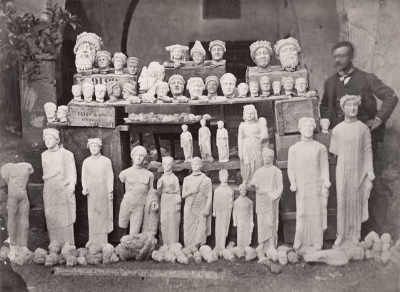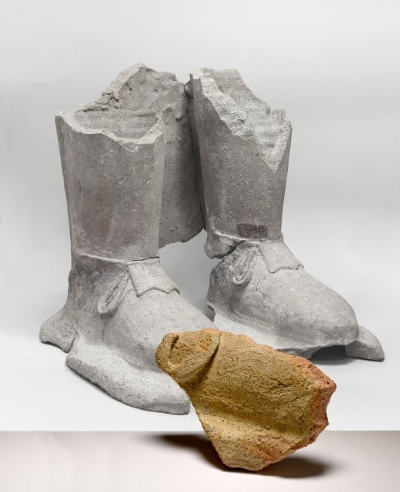
© Facebok Τμήμα Αρχαιοτήτων Κύπρου/ Department of Antiquities Cyprus
У гірській долині поблизу Пера Орейніс, неподалік від древнього міста-держави Тамассос, вчені з Німеччини виявили втрачений храм Аполлона — бога світла, мистецтва і пророцтв. Розкопки очолюють фахівці з Франкфуртського та Кільського університетів. Вони ідентифікували місцезнаходження храму на основі архівних матеріалів ще з 1885 року, коли німецький дослідник Макс Онефальш-Ріхтер уперше провів там розкопки. Тоді частину артефактів було зібрано, але саму територію — через поспіх і недосконалі методи — знову засипано. І от через 135 років сучасні технології, зокрема георадар, допомогли точно локалізувати це місце. Серед найвражаючих знахідок — фрагменти гігантських статуй з вапняку та теракоти, зокрема людські фігури у повний зріст, кіннотники та колісниці. За словами археологів, подібні об’єкти не трапляються в похованнях чи поселеннях — це явні свідчення функціонування великого святилища. Багато з фігур були присвятами від паломників — традиційна практика в храмах Аполлона. Цікаво, що частина артефактів із цього місця давно зберігається у музеях Великої Британії, Канади, Ірландії, а можливо — й Росії. Лише небагато залишилось у самому Кіпрі, зокрема знаменитий «Колос Тамассосу» в Кіпрському музеї. Окрім скульптур, археологи натрапляють на давньогрецькі та кіпрські написи, амулети, фрагменти мармурового скла, а також залишки архітектурних елементів — подвійну кладку, ймовірно, стін храму. Усе це дозволяє припустити, що храм функціонував упродовж кількох епох — від залізного віку до пізньої античності. Остаточне підтвердження, що знайдена локація є саме легендарним святилищем Аполлона, дало виявлення слідів старої траншеї завдовжки 15 метрів — ідентичної тій, що згадується у звітах розкопок 1885 року. Нові широкомасштабні дослідження території тривають постійно. Знахідки храму Аполлона вчені називають шансом по-новому поглянути на релігійне життя Середземномор’я у давнину.
The Lost Temple of Apollo in Cyprus Continues to Astonish Scholars with New Discoveries
In a mountainous valley near Pera Oreinis, close to the ancient city-kingdom of Tamassos, German archaeologists have uncovered the long-lost Temple of Apollo — the ancient Greek god of light, the arts, and prophecy. The excavation is being led by researchers from the universities of Frankfurt and Kiel, who identified the site based on archival materials dating back to 1885. That year, German archaeologist Max Ohnefalsch-Richter conducted the first digs at the location. However, due to haste and limited excavation methods, much of the area was reburied, and the temple’s precise location was forgotten for more than a century. Now, 135 years later, modern technologies — including ground-penetrating radar — have allowed researchers to accurately pinpoint and re-explore the sanctuary. Among the most striking finds are fragments of colossal limestone and terracotta statues, including life-size human figures, horsemen, and chariots. According to archaeologists, such artifacts are not typically found in settlements or burial sites — strongly suggesting the presence of a large and significant sanctuary. Many of the figures are believed to have been votive offerings from ancient worshippers, a common practice in temples dedicated to Apollo. Remarkably, several artifacts from this site have long resided in museums in the UK, Canada, Ireland, and possibly Russia. Only a small number remain in Cyprus itself — including the famous “Colossus of Tamassos,” which is housed in the Cyprus Museum. In addition to sculptures, the team has uncovered inscriptions in Ancient Greek and the Cypro-Syllabic script, amulets, fragments of marble-like glass, and structural remains such as double-shell masonry — likely parts of the temple’s original architecture. These findings suggest that the sanctuary was in use across multiple eras, from the Iron Age through the Archaic and Classical periods, and even into late antiquity. Crucial confirmation that this is indeed the legendary Sanctuary of Apollo came with the discovery of a 15-meter-long trench — exactly matching descriptions from the 1885 excavation reports. Extensive archaeological work at the site is ongoing. Researchers see the rediscovery of Apollo’s sanctuary not only as a spectacular historical event, but also as an opportunity to gain new insights into the spiritual and cultural life of the ancient Mediterranean world.

©
171